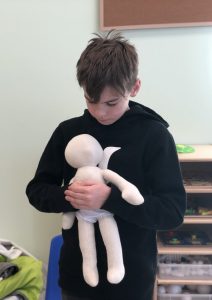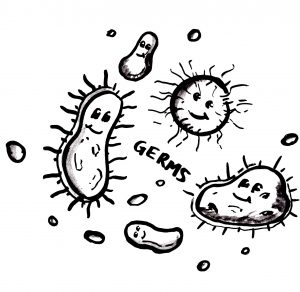Author: Layal Bou Abdo MSN
The hurly-burly holidays are fun and exciting times of the year for many families. Yet, holiday decorations, parties and cold weather come hand in hand with hazards, especially for children. Many of us are celebrating holiday traditions alone due to COVID-19, but we must keep extra precautions this year to many health and safety threats in particular. Here are 7 Health and Safety tips for keeping children safe during the Holiday Season
Fire safety
- Assess holiday decorations, lights and extension cords for damages or exposed cords.
- Keep cords out of the way or behind furniture, and insert electrical outlet covers into any unused outlets.
- If you are using an artificial tree, make sure that they are flame resistant (fire-retardant).
- If you are using a “real” tree, make sure it’s well watered. A dried-out Christmas tree fire burns quickly with a flashover occurring less than a minute.
- Avoid overloading the electrical outlets because they might get overheated.
- Check smoke detectors on a monthly basis and make sure to change batteries as often as recommended by the manufacturer.
- Do you have a fire blanket and extinguisher at home? You might consider having them for your New Year Resolution.
- We recommend switching decorating light and candles off before leaving your house and going to bed.
- Do not leave children alone in a room with lighted candles, matches, lighters, fireplaces or any other sources of flame or heat.
- Keep Children well supervised if they are helping you with the decoration with lighting.
- Keep the tree in a sturdy stand to prevent it from being knocked out by kids.
- Inspect your chimney and clean it every season by a certified chimney professional to ensure that it is safe to use. Never burn paper or pine boughs, since those materials can float out of the chimney and ignite a nearby home or your own roof.
- Use the Canadian Standards Association (CSA) approved light sets only.
- Use the right light for the right place. Use indoor light for the indoors as they are not waterproof. Outdoor light might get overheated, so keep it for the outside. We recommend the use of LED lights not just because they are more eco-friendly but because they do not generate heat.
- Avoid running cords under the carpets or coiling a bunch of cords together as this may cause the cable to overheat and pose a fire hazard.
- Use battery-operated candles when possible.
- Kitchen appliances should be clean to prevent potential fires.
- Remove all wrapping papers, bags, paper, ribbons and bows from tree and fireplace areas after gifts are opened. These items can pose suffocation and choking hazards to a small child or can cause a fire if near a flame.
- Talk to your children about the dangers presented by all these fire hazards.
Toys Safety
- The age recommendation on toys is about safety and not the children’s ability to master the toy or the game. We recommend always respect the manufacturer’s age recommendation when purchasing a toy for your child.
- Inspect toys for wear and tear and condition before offering them to your child. We also recommend reading all safety instructions before you offer it to your child.
- A general rule for children younger than 3 years of age: toys should be bigger than the child’s fist to avoid the risk of choking.
- Avoid toys with long strings or cords for babies and toddlers to prevent the risk of strangulation. Also, avoid toys with magnets with small kids because if swallowed, the magnet can cause death.
- Inspect the battery-operated toys well for battery leakage. Old batteries can leak and cause corrosive burns. Moreover, make sure to secure batteries inside the toy to prevent your child from swallowing it (bottom batteries).
- Be careful of gift wrappings, such as bags, paper, ribbons and bows.

Heimlich Maneuver
Choking and Swallowing
- As a general rule, anything that can fit in the mouth of a baby or toddler is a choking hazard.
- Choking hazards examples: ornaments, small toys, food such as peanuts or popcorn, tree needles.

Broken bones
Fall, Slip, Injuries and Sledding Safety
- Keep breakable and sharp ornaments away from younger kids, near the treetop for example, as they might cause a risk of injuries.
- Display decoration in a way to keep free spaces in the house to prevent the risk of tripping.
- Watch for black ice to prevent slipping.
- Kids must wear appropriate shoes with non-slip soles when playing outdoor.
- Sledding safety:
- Sledding and tubing can be a great way to enjoy the winter weather. The joy of speeding down the hill could be unforgettable but also it could lead to injuries. Injuries can occur when the sled hits an object and cause a child to fall off. Injuries can be minor (bruises, cuts), moderate (broken bones) or severe (head and neck injuries that could be sometimes fatal). Here are sledding safety tips:
- Kids should wear a helmet (a bicycle helmet for example).
- Chose a sled that could be steered over flat sheets, snow discs and toboggans.
- Watch your child all the time.
- Avoid sledding in areas with trees, fences and light poles or on rocky hills. Also, avoid sledding on the street, on driveways, hills, or slopes that end in a street, drop off, parking lot, river or pond.
- Kids should sled down the hill feet first and learn how to stop the sled using their feet.
- Respect the recommended number of passengers allowed on the sled.
- Sled should never be pulled by a motorized vehicle such as a car or a snowmobile.
- The best place to use a tube is in a tubing park because they are hard to steer.
- Sledding and tubing can be a great way to enjoy the winter weather. The joy of speeding down the hill could be unforgettable but also it could lead to injuries. Injuries can occur when the sled hits an object and cause a child to fall off. Injuries can be minor (bruises, cuts), moderate (broken bones) or severe (head and neck injuries that could be sometimes fatal). Here are sledding safety tips:
Poisoning and Healthy Eating
- Plant poisoning: Mistletoe, holly, Jerusalem cherry plants, and other plants used as decorations are poisonous. Keep the berries of these plants out of reach of children. Symptoms like rash, nausea, vomiting and diarrhea. If you suspect that your child has ingested berries from these poisonous plants please call the Ontario Poison Control Center on 1-800-268-9017 (Toll-Free), 416-813-5900 (Toronto).
Poinsettia plants are not poisonous, but they can still cause skin irritation and stomach upset if eaten.
- “Bubble lights” containing methylene chloride can be poisonous if a child drinks the fluid from them (even if labelled nontoxic).
- Use the aerosol propellants properly as snow sprays may be harmful.
- Food Safety:
- Food Poisoning:
- If food is not properly stored, cooked, or handled, it can make you seriously sick and cause food poisoning (gastroenteritis).
- Practice food safety by washing hands, utensils, dishes and surfaces that comes in contact with raw eggs, meat, fish or poultry.
- Only one small mistake needs to happen for salmonella, listeria, campylobacter or E.coli to invade your food.
- Do not leave the food out for too long,
- Cover and put food back in the refrigerator.
- Cook the meat and fish at the proper temperature.
- Wash fruits and vegetables thoroughly
- Verify if the food smells differently (sour milk? Mold?)
- Heat the leftover food before you eat it (to kill the bacteria)
- Check for expiry date
- If food is not properly stored, cooked, or handled, it can make you seriously sick and cause food poisoning (gastroenteritis).
- Alcohol Poisoning
- Alcohol poisoning is a very common risk for children. Remove all empty or partially empty cups, bottles or cans as soon as possible. Keep alcohol away from the reach of children. Even a small amount of alcohol might be toxic for kids.
- Healthy eating
- During holiday times we tend to eat lots of food and sweets. It is reasonable to have some extra treats around the holidays but try to celebrate for the day, not the entire month. Be sure to return to healthy eating the next day!
- Foods with added sugar and solid fat can fill you up and not leave room for healthier foods. Also, eating foods high in added sugar or solid fats can lead to many serious health problems.
- Keep healthy eating in mind. Have healthy snacks on hand and eat lots of fruits and vegetables.
- Food allergies and anaphylaxis (severe allergic reaction)
- Any food can cause an allergic reaction, but most are caused by eggs, peanuts, tree nuts, milk, soy, fish, wheat, shellfish.
- If you are baking or preparing food for others to offer during the holidays make sure to know if they have any kind of allergies.
- Always read food labels
- Check with parents before giving any food to children
- We recommend you chose non-treat food for children and replace them with gadgets or toys.
- Wash your hands to prevent cross-contamination
- Supply the list of ingredients for anything you prepare or bake at home
- Food Poisoning:
- Respiratory Symptoms:

Germs
-
- If someone is having a cold or recovering from an illness, hold off on hugs, handshakes and kisses.
- During the pandemic, keep practicing the recommendation of Health Canada of social distancing, hand hygiene and wearing masks.
- When someone sneezes or coughs, mucus drops float in the air. Breathing in these droplets can spread the virus from one person to another even if someone touches the eyes, nose, or mouth after handling something with cold / influenza/ COVID-19 viruses on it.
- Practice Hand hygiene & Disinfect frequently touched surfaces.
- Avoid large crowds & busy places.
- Stay at least 6 feet from people you don’t live with.
- Wear a mask when in public
- Do not touch their eyes, nose, or mouth.
Hypothermia

Warming blanket in Hypothermia
- If your child has been outside on a freezing day without wearing appropriate winter cloth, he might get hypothermia.
- Hypothermia is when the body temperature falls below 35 degrees Celsius or 95 degrees Fahrenheit.
- Watch for those signs and symptoms:
- Shivering (should be your guide)
- Slurred speech,
- Fumbling with the hands
- Exhaustion
- Memory loss
- Confusion
- Fatigue
- Levels of hypothermia
- If shivering stopped on their own, the hypothermia is mild.
- If shivering cannot stop, the hypothermia is moderate
- Seek medical attention if the body temperature lowers to dangerous levels, shivering will stop completely. The heart rate will slow and the person will gradually lose consciousness.
- Remove the child from the cold and remove any wet clothing
- Warm the child with warm blankets around the body, especially the neck and chest.
- Offer a warm beverage if the person is able to drink.
- Share body heat by using skin-to-skin contact by lying next to the child.
- Cover yourself and the child with a warm blanket.
- If your child begins shaking violently or becomes confused, call 9-1-1.
- If breathing becomes very shallow or non-existent, begin CPR.
Mental Health
Keep mental health a priority, specifically during the periods of lockdown due to the pandemic.
- Try to stick to your child’s usual routines;
- Take care of yourself both mentally and physically. If you are ok, your child will be OK.
- Involve your children with holiday preparations.
- Create your own holiday traditions (gift wrapping, DIY ornament projects, making gifts, etc).
- Daily outdoor time is so important for the mental health of the child.
- Most important of all, enjoy the holidays for what they are—time to enjoy with your family. Do things together like sledding or playing board games, and spend time visiting with relatives, neighbours, and friends, even if virtually.
Listen to this interview segment with our managing partner Layal Bou Abdo talking about this topic

